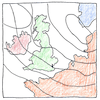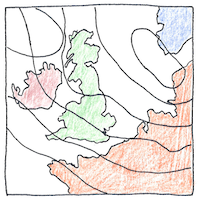Vilhelm Bjerknes, Jacob Bjerknes
atmospheric sciences

|
Weather forecasting
Vilhelm Bjerknes believed a mathematical model could help predict the weather. Existing models were not adequate, so he combined fluid dynamics with thermodynamics. His equations, applied to oceanic and atmospheric motions, made modern weather forecasting feasible. After World War I, he and his son, Jacob, working together on the life-cycle of mid-latitude cyclones, realized that most weather activity, borrowing a concept from the war, happens at the fronts— at the boundaries between air masses.
Forecasting difficulty
Step out from under the trees to check for clouds. Wet a finger in your mouth then raise it in the air; which side is cooler tells the direction of the wind. Otherwise, in trying to predict the weather, it is difficult to get good data, difficult to model atmospheric and oceanic processes, and difficult to put it all together in a reasonable time. To make matters worse, weather is chaotic, so the further into the future you try to predict the less accurate your predictions will turn out to be.
Crystal ball
If you had a crystal ball would you use it to get rich or would you try to help others? Would people believe you? Would you try to convince them? Would knowing give you the means of making things better for everyone? Could you alter the future, really, or would your trying to do so already be a part of what your crystal ball would show you?



“Everybody complains about it, but nobody does anything about it.” Weather is a good topic of conversation wherever you are, whomever you are with, because it affects almost everybody but rarely offends anybody, amd it can lead to more personal conversations. Weather affects agriculture, air and marine traffic, and other human activities, so that both accurate and inaccurate weather prediction have huge social and economic effects.
See also in The book of science:
Readings in wikipedia: